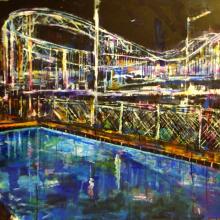
When three artist friends embarked on a mid-week trip to Blackpool last January, they had in mind a bracing view of the sea, some fish and chips, and a nostalgic ride on the big dipper.
Instead, what they found was 'a desolate, desperate ghost town dripping in melancholy and devoid of any of the fizz or luminosity experienced in sickly abundance during high season'.
It is precisely this sense of delicious disappointment which pervades Goodall, Harman and Liddle’s Funpark, July’s brilliantly dark exhibition at the Union Gallery.
Showing here by Robin Goodall are six screen prints on aluminium sheets. In these heavily worked pieces, the action of ‘screening, layering, then scratching, eliminating and embellishing’ the surface parallels processes of oxidization, decay and dilapidation in the wood and metal skeletons of the leisure industry. My favourites were the two least abstract images: both of the disintegrating Ferris wheel in Spree Park, Berlin.

‘Ferris Study I‘ shows a foreground of fence, with trees beyond and the towering Ferris wheel itself in the background. A little depth is conveyed through pale green and candyfloss pink. ‘Ferris Study II’ (above) shows the scene again, but is greyer and flatter. Natural and manmade shapes merge. The effect is odd: somehow both dull and discomfiting, sinister and banal. The fence excludes and entraps like the barrier around some military secret or a prison camp. The lack of perspective suggests a difficulty in – perhaps the impossibility of – reaching the promised source of gratification.
Natalie Liddle’s multi-layered photographs are similarly ambivalent. Combining her own film with the projected images of her grandfather’s slides, she produces dreamlike composites of memory and fleeting observation. These are personal accounts which – in highlighting the spool holes of the film itself – also celebrate their own artifice.

Her fairground scenes have much to say on entropy, mortality and the impermanence of pleasure, but I find tenderness here, too. Her blood-reds are rooted in the beating hearts, the G-forced bruises on the muscles of her mostly unseen cast. Occasional ghosts stare from the images to fix one’s gaze, iron networks have the intricacy and vulnerability of insect wings, and in ‘Wild River’, an old sign boasts of thrills perhaps never truly realised on this rickety gutter. The paradox of the ride’s name is simultaneously touching and bathetic: ‘Wild River’ – manmade and evidently tame – hardly even runs with water.
Liddle’s beautiful complexities of shape and sentiment are a revelation. ‘Helter Skelter’ ‘Carousel’ and 'Fantasy Island' (above) were among my favourites.
The big beast in Funpark is of course Norrie Harman, the Westerhailes-born and raised artist whose mix of superb technique, visceral honesty, and exhibition hutzpa provoked column inches during last year’s solo exhibition Way Out West and is doing so again now.
There is no escaping the enormous 'Black Ices' (oil on panel, 12ft X 8 ft), which occupies the whole of Union Gallery’s back wall. It shows full-sized an ice cream van, gaudily lit from within and below, against a night sky and distant funfair.
In Harman’s much smaller study for this painting (below), also showing in the exhibition, there are noticeably more glowing blues and golds. Here is the vibrant and slightly frightening store of illicit treats found on many housing schemes of the 1970s and '80s. It reminded me of the Childcatcher’s irresistible trap in Chitty Chitty Bang Bang, of the throbbing UFO in Close Encounters, of Doc Brown’s DeLorean in Back to the Future.

But in its larger incarnation, the van – though still brilliantly lit – is somehow sicklier: bilious red, green and yellow drips descend over it like body fluids. Harman may sometimes revel in anarchic delights, yet he is not blind to their consequences.
Whilst Black Ices is an unmissable showstopper, as was evident last year Harman can also pull off large effects with monocrome watercolour and India ink. The structure at the heart of ‘Rollercoaster’ (below) resembles the undulating bulk of a brontosaurus, and yet it is its invisible population which animates the work. The raw power of their past excitement seems to bend the elements, funnel winds, shape clouds, energise the fabric of the sky. It is perhaps a study for the extraordinary 'Fluorescent Rolleroaster' (top-right), but equally strong in its own right.

Other examples of Harman’s work here are – to my mind – quieter but by no means less interesting. ‘Funpark’ (below) reviews faded Portobello in blocks of colour.

Ignore the (ironically chosen) horrible blue frame, and in ‘Tangerine Dream’ one finds a sunset cityscape reflectively recalled. The artist may be willing to enjoy those entrancing bright lights below, but he remains at one remove. This is a measured response, not an attempt to repeat the participative experience itself.
Similarly, ‘Sex Swing’, for all its attention-grabbing title, is a painting of considerable emotional depth. It is a work remarkable for the economy of its brushstrokes, its subtle tones of affection, candour and regret.
'Sex Swing' encapsulates the smiling sadness of all three artists here. In it, we encounter the unsettling truths that often people are not understood till gone, that love is sometimes best appreciated lost or spent. AM
Funpark continues at the Union Gallery (45 Broughton Street) until 31 July.
Is there an exhibition or individual work in Broughton which you'd like to write about? We'd love to hear from you. Contact us by email spurtle@hotmail.co.uk on Facebook Broughton Spurtle or Twitter @theSpurtle